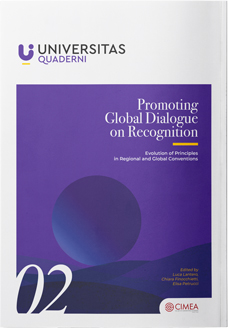
Universitas Quaderni 02/2025
Promoting Global Dialogue on Recognition
Evolution of Principles in Regional and
Global Conventions
Edited by: Edited by Chiara Finocchietti, Luca Lantero, Elisa Petrucci
Published:
Abstract
The recognition of qualifications has become a cornerstone of internationalisation in higher education, shaping mobility flows and fostering cooperation across regions. In this context, different Conventions – at regional and global level – were adopted to establish common principles and mechanisms for fair and transparent recognition.
Through a comparative analysis of the texts of the regional recognition Conventions and the Global Convention, taking the European Lisbon Recognition Convention as a key reference point, this volume examines the evolution of their key concepts and how they reflect broader political and cultural developments in higher education, internationalisation, mobility, and recognition. The study also traces the historical background, highlighting how specific mobility flows influenced the drafting and adoption of the regional recognition Conventions.
Instead of presenting ready-made solutions, the study seeks to advance global dialogue on recognition by involving different stakeholders at national, regional and international levels. In doing so, it enriches the debate, promotes new research and supports the development of future cooperation initiatives.
Authors: Chiara Finocchietti, Emanuela Gitto, Luca Lantero, Elisa Petrucci, Francesco Sanasi.
Keywords:
Recognition of Qualifications, Lisbon Recognition Convention, Regional and Global Convention, Higher Education Internationalisation, Evolution of Recognition Principles, International Mobility
In Evidenza
Articoli recenti
Non è disponibile ancora nessun articolo recente.
